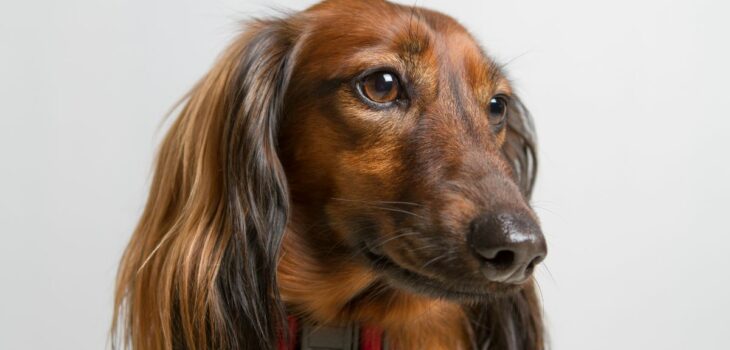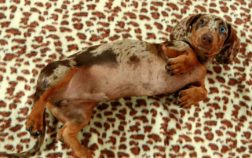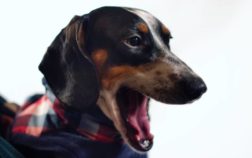Pattern baldness in dachshunds is a common problem that many of these adorable dogs unfortunately suffer from. Let’s find out everything you need to know about this dachshund skin condition, including how to spot it and the best treatments!
What Is Pattern Baldness In Dachshunds?
It is not uncommon to see dachshunds that have thinned hair on specific areas of the body, and this is due to a form of dachshund alopecia called pattern baldness.
Pattern baldness is thought to be a hereditary condition, although the genetic link has not yet been identified. It is known that dachshunds that carry the coat color dilution gene are predisposed to a type of pattern baldness called Color Dilution Alopecia (CDA).
Dogs with the coat color dilution gene are those that have a paler coat than normal. Black colors fade to grey, and chocolate brown fades to a milky light brown.
While these colorings are highly sought after, they can develop significant hairless areas of skin, particularly on the ears.

Symptoms Of Pattern Baldness In Dachshunds
There are three different types of pattern baldness; all three can affect dachshunds, but some are more common than others.
The form seen most often in female dachshunds causes hair loss around the forehead, under the neck, and on the chest, belly, and back of the hind legs.
Dachshunds are also very prone to a form of pattern baldness called pinnal alopecia, where the hair is lost from both ears. This is most frequently seen in male dachshunds, although it can occur in both genders.
The final form of pattern baldness, saddle alopecia, is very rare in dachshunds. This causes baldness under the neck, on the tail, and on the hind legs.
The main identifying feature of pattern baldness is that it is always symmetrical – the hair loss will be the same on both sides of the body. It is normally very gradual, and you will only see a slight thinning of the hair initially. Over time the skin can become completely hair-free and bald.
Another significant feature of pattern baldness is that it does not cause the dog any pain or irritation. You will not see any reddening or thickening of the skin, and the skin itself will look completely normal. If you see your dog suffering from itchy or sore skin, then pattern baldness is most likely not the problem.
However, baldness can leave the skin exposed to the effects of sunlight and airborne pathogens, increasing the risk of sunburn, skin cancer, and dermatitis. This is a particular problem in dogs with extensive areas of exposed skin that spend many hours out in strong sunlight.

Treatment For Pattern Baldness In Dachshunds
As this condition is considered to be cosmetic, treatment is not normally used to stop or slow the progression of pattern baldness in dachshunds. Some dogs will spontaneously regrow hair if they have seasonal alopecia, but many never regrow the hair at all. Hair that does regrow tends to be lighter in color.
In some situations, the progression of pattern baldness can be slowed if it has been triggered by an external factor such as the use of skin medication. However, in most cases it is just left to run its course.
If your dog suffers from large areas of hairless skin, these bald patches can become sun burnt in hot weather. Avoid walking your dog in direct sunlight, and use a pet-safe sun protection cream if necessary. Repeated sun burn can lead to a risk of skin cancer, particularly on the sensitive skin on the ears.
How To Avoid Pattern Baldness In Dachshunds
The problem of pattern baldness in dachshunds is widespread, and many breeders are taking steps to try and limit the incidence of this problem. Although pattern baldness is not necessarily painful for your dachshund, cosmetically it is considered undesirable.
Unfortunately, there is no genetic test yet available to identify which potential dachshund parents carry the gene that leads to pattern baldness. So, for now, breeders tend to avoid breeding from dogs that have pattern baldness, or that have produced puppies that go on to develop pattern baldness. As this condition can take a year or two to manifest itself, this does mean that dachshunds carrying the pattern baldness gene are sometime accidentally used for breeding.
This means that some dachshund breeders will no longer breed from dachshunds with dilute coloring – Blue or Isabella – as they do not want to breed puppies with pattern baldness. Unfortunately these rare coat colors are highly sought after by pet owners, and they attract a high price tag. This makes breeding them an enticing prospect, despite the potential that the offspring will develop significant pattern baldness.
Although pattern baldness does not cause many problems for dachshunds, it is preferable to take steps to avoid it if at all possible. If you are looking to buy a dachshund puppy, make sure you get to see both parents to check for pattern baldness. Stick to solid-colored dachshunds such as the traditional black and tan markings.
Summary
So, as we have learned, pattern baldness in dachshunds manifests as symmetrical hair loss on specific areas of the body, most commonly the ears. It is not a painful condition and the hair loss can be very gradual. However, baldness can leave the skin exposed to the effects of sunlight and airborne pathogens, increasing the risk of sunburn, skin cancer, and dermatitis.

We’d love to hear your thoughts on pattern baldness in dachshunds! Have you ever come across a hairless wiener dog that suffered from this common skin condition? Or perhaps you have noticed your dachshund losing hair and you are trying to find the best treatment for this problem? Leave a comment below and we will get back to you!




